Interview conducted by editor Derek O’Leary
Jeroen Dewulf is the Queen Beatrix Professor in Dutch Studies and an Associate Professor of German Studies at UC Berkeley, where he also directs the Institute of European Studies. His new book, The Pinkster King and the King of Kongo: The Forgotten History of America’s Dutch-Owned Slaves (University Press of Mississippi, 2017), departs from a study of nineteenth-century Pinkster, which has generally been considered a syncretic Dutch-Afro performance clustered in the formerly Dutch colonial territories of New York. Through a careful excavation of these rituals, he resituates an apparently local story in a much broader and deeper Atlantic context. His study casts light on the origins of Pinkster in a very different syncretism–of Iberian and African cultures on African soil–and the crucial role of mutual-aid associations in its transmission and promotion. For students of the intellectual and cultural history of the Atlantic, it provides a compelling model for circum-Atlantic history (to borrow from David Armitage’s typology), while encouraging us to reconsider our understanding of syncretism.

Derek: If we look at the longer trajectory of popular and scholarly impressions of New Netherlands and Dutch heritage in the US, there seems to be something especially malleable about how people have understood the Dutch. This ranges among the extremes of Washington Irving’s burlesque notions of the Dutch in the early nineteenth century, to Holland Mania later that century, to obliviousness at various times of the Dutch presence in North America. Your book takes as point of departure certain nineteenth-century misperceptions of Pinkster as an originally Dutch and African syncretic phenomenon that the Dutch gradually lost interest in. Such misperception seems due, in part, to the fact that the Dutch and their descendants rarely told their own history of the life in North America. Could you talk about why this is the case?
Jeroen: It is important to highlight the topic of language as such. Even within the Dutch community in America, preserving Dutch attachment to the language is an interesting topic, and you see as a general rule that as soon as people of Dutch descent achieved positions of power, their attachment to the language tended to disappear. And those who held on to Dutch were often farmers or rural inhabitants, which has consequences on the way the story is told.
On top of language, we have the matter of religion, another important element here. The Dutch had their own religion in a way: the Dutch Reformed Church. And having your own religion isolated the Dutch community from others. And then you also clearly see a division within the Dutch community, between those who abandon this history as soon as New Netherland becomes New York, and those who hold onto it. And those who hold onto it are not necessarily those who write. So, you have relatively few documents in which you hear a Dutch voice commenting on Dutch traditions in America.
As a result of this, the way we have told the history of New Netherlands is one heavily influenced by an Anglo-Saxon perspective, which would look at this Dutch heritage and make it correspond to a perception that they already had of it. It is also very important to keep in mind that there was no such thing as Dutch newspapers, so the voice of the media was an English voice.
Derek: Your study explores a sort of “double erasure” in this context, of both Dutch voices and members of the Afro-Dutch community.
Jeroen: Who is aware that in the mid-eighteenth century that about 10-15% of blacks in New York still spoke Dutch? The Dutch and African linguistic heritage of the region are similarly forgotten. Little attention has been given to the fact that African-American history is a multilingual history, and not just in the sense of bringing different languages from Africa.
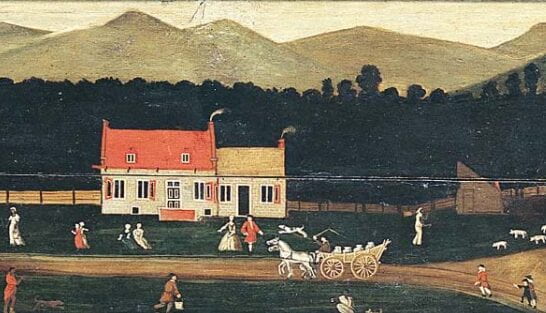
Middle panel of 1733 painting by John Heaton of Van Bergen farm near Albany, NY: One of the few images depicting African American slaves on a Dutch-owned farm at a time when about 10-15% of the slaves living in the states of New York and New Jersey spoke Dutch.
Derek: Ironically, then, the erasure of Dutch voices from the nineteenth-century record seems to contribute to the erasure of the African and Portuguese origins of Pinkster. Your book takes a phenomenon—Pinkster– that has also, like this Dutch-American history, been interpreted in a very malleable way, and pulls it from a local context into a much more complex Atlantic context. In the process, the long-imagined Dutch influence on this Afro-American phenomenon recedes, and it becomes much less a story of the Dutch legacy in America. Much of the past few decades of historiography on the Dutch colonies in the Western Hemisphere have sought to reinsert them into both US and Atlantic history, so in an interesting way your book departs from this—indeed, it distances Dutch influence from a circum-Atlantic phenomenon of Pinkster, and directs us to see its roots elsewhere.
Jeroen: The book didn’t take me in the direction I was planning to go, and in a certain sense the book wrote itself. Originally, I thought this would be about performance culture, but it ended up being much more about mutual aid and solidarity and community-building. I also expected it to be a much more Dutch book, which it did not turn out to be. That was a surprise to me in the sense that what became clear is that we are speaking about a time period when Dutch Atlantic history was starting, and as a newcomer you naturally don’t build things out of nowhere: You build on what is already there. Especially when it comes to the process of slavery, we see how strong the continuation of Iberian model was among those who took over from the Spanish and Portuguese in the seventeenth and eighteenth century. I felt that this element has been underestimated by people who write about Atlantic History.
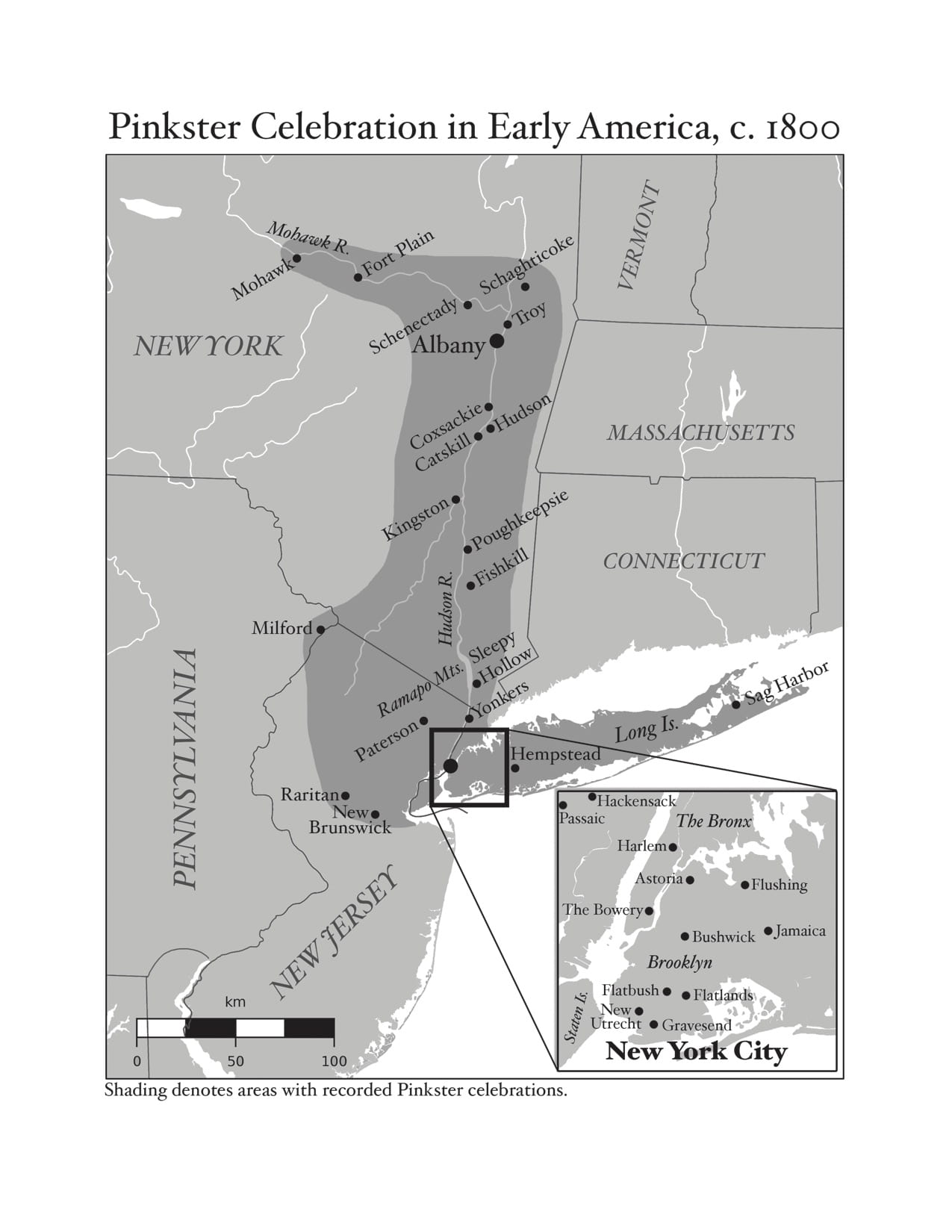 We still have this assumption that scholars choose “their” nation, and then tend to give too much importance to the colonizer of a specific area: If you focus on New Netherland you focus on the Dutch, if you write about New England you focus on the English, etc. But especially when you focus on a field such as slavery, its Atlantic complexity forces you to use a perspective that tries to capture this vast area, and you realize that holding on to this one-nation perspective is just not providing you with the answers to the challenging questions that manuscripts raise. Pinkster is a good example of this. It has traditionally been reduced to a “syncretic Dutch-African” tradition, which is true in the sense that there certainly are Dutch and African elements to be found in the tradition, but to say that something is syncretic doesn’t mean much. In fact, Pinkster is so much more complex than just a “mixture of Dutch and African” elements.
We still have this assumption that scholars choose “their” nation, and then tend to give too much importance to the colonizer of a specific area: If you focus on New Netherland you focus on the Dutch, if you write about New England you focus on the English, etc. But especially when you focus on a field such as slavery, its Atlantic complexity forces you to use a perspective that tries to capture this vast area, and you realize that holding on to this one-nation perspective is just not providing you with the answers to the challenging questions that manuscripts raise. Pinkster is a good example of this. It has traditionally been reduced to a “syncretic Dutch-African” tradition, which is true in the sense that there certainly are Dutch and African elements to be found in the tradition, but to say that something is syncretic doesn’t mean much. In fact, Pinkster is so much more complex than just a “mixture of Dutch and African” elements.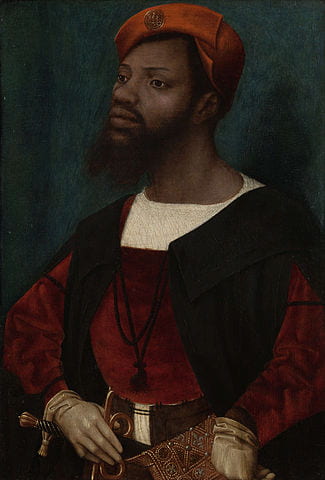
Jan Mosatert, Portrait of an African man, circa 1525-1530: An early connection between the traditional Pinkster (Pentecost) celebration in Dutch culture and Africa is this painting, depicting a unidentified black man from the sixteenth-century who wears in his hat a badge that indicates a visit to the Black Madonna of Halle, who is honored every Pentecost with a procession
Concerning Pinkster, I think we see this performance in New York, see Africans participating, and immediately jump to the explanation that it is a Dutch-African syncretic process. When it comes to African-American traditions, it is much too easy to remain superficial and assert the usual things (e.g. they are honoring their ancestors) while avoiding more challenging questions, such as how ancestor worship would vary by region, for instance. Also, when we think about syncretism, we make a mistake in limiting syncretism to the Americas and the Caribbean, and do not apply the notion to Africa.
Syncretism in a way can correct the traditional approach, whereby you would assume clear boundaries between cultures, as syncretism forces you to look at two cultures producing something new. But even that is too simple, because those two cultures are themselves full of syncretisms.
Derek: In the comparative study of empire in the Atlantic, though, I think that we are still inclined to see a certain Dutch exceptionalism–that it was basically different than the other European colonial projects there. Indeed, as you note, there may have been a particularly Dutch colonial capacity to adopt the techniques and technologies—and, as we see here, integrate the customs—of other colonial projects in the Atlantic. But your study is also intriguing because it suggests we can look around the Atlantic, within other colonial projects, and find more complicated stories of syncretism as well. Was there something about the Dutch Atlantic project that made it more open to such transmission of culture and ideas?
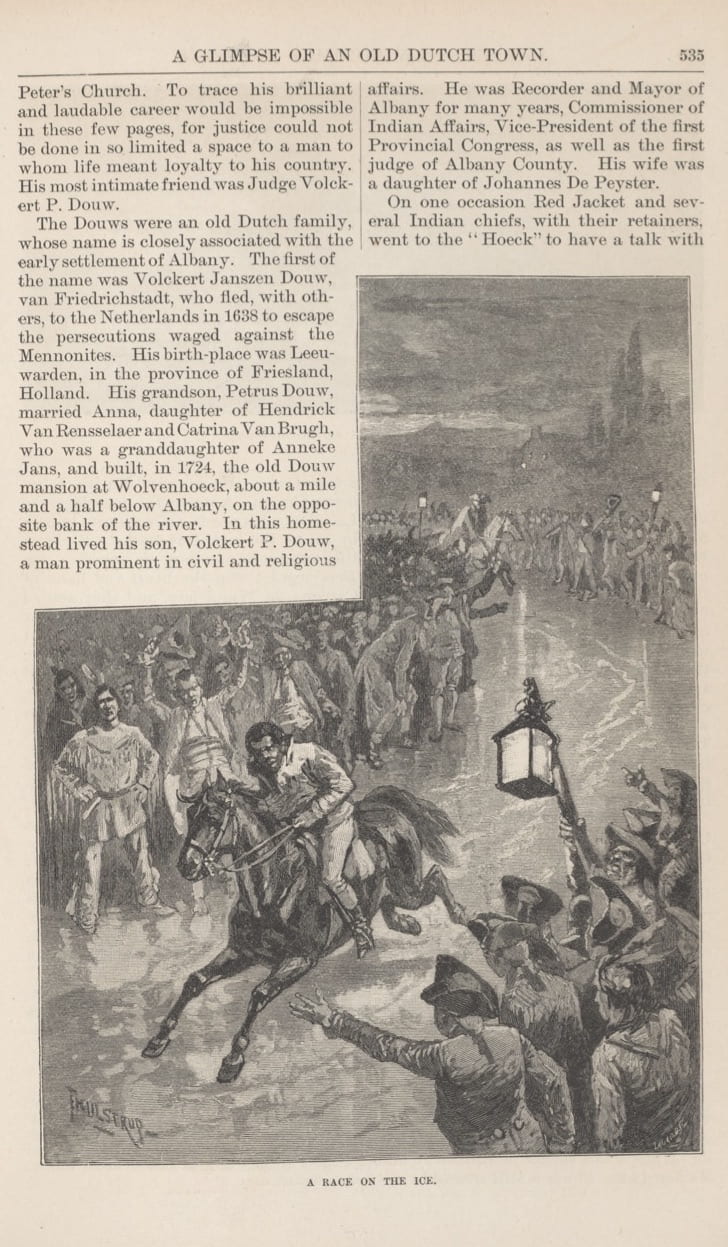
King Charles Racing on Ice.
“Artist’s conception of Charles, the Pinkster king, winning a nightly horse racing competition for his master Volkert Petrus Douw against General Philip Schuyler. In Harper’s New Monthly Magazine 62 (March 1881)” (Dewulf, 64).
Jeroen: There were definitely certain elements that the Dutch brought to the Atlantic that singled them out, including religion. When you see how the Dutch initiate slavery in their colonies, initially the way slavery is handled is similar to how it was handled by the Portuguese and Spanish, but soon you see that because of their different notions of religion, they start to change these practices. The example I give is baptism and the consequences of welcoming someone to your church, as the Dutch notion of Christianity and freedom was different than the Iberian notion, which led the Dutch to change their slave policy. In fact, the Dutch Reformed Church initially baptized slave children, similar to how the Iberian Catholic Church did, but stopped doing so after slave owners began to fear that once these children were admitted to the Church, they would no longer be able to sell them as slaves. Had this earlier process continued, I’m convinced that Pinkster would have disappeared, because the mutual-aid traditions out of which the African Pinkster celebrations developed would have been incompatible with Calvinist morality and mutual aid would have been provided within the context of the Church anyway. But it survived because at one point the church came under pressure from slave owners who opposed baptism, which gave those communities no other choice but to organize mutual aid on their own, for which they naturally used a brotherhood structure they were familiar with. Which also then explains the demise of the tradition, when the first black Christian churches come into existence in the nineteenth century and a Protestant morality becomes dominant within the African-American community. So, there was some form of Dutch exceptionalism in the Americas, but it developed only gradually, they had to learn to be an Atlantic power.
When people use the term “exceptionalism” and link it to the Dutch, there is a tendency to link it to pragmatism and tolerance. But what I’ve tried to highlight is that we would make a mistake if we assumed that the existence of Pinkster was solely there because the Dutch were so tolerant to allow it to happen. There clearly was within a slave community a strategy used to make the Dutch realize that it was in their own interest, so it appears as pragmatism, but it is not something that would have happened without pressure from the slave community.
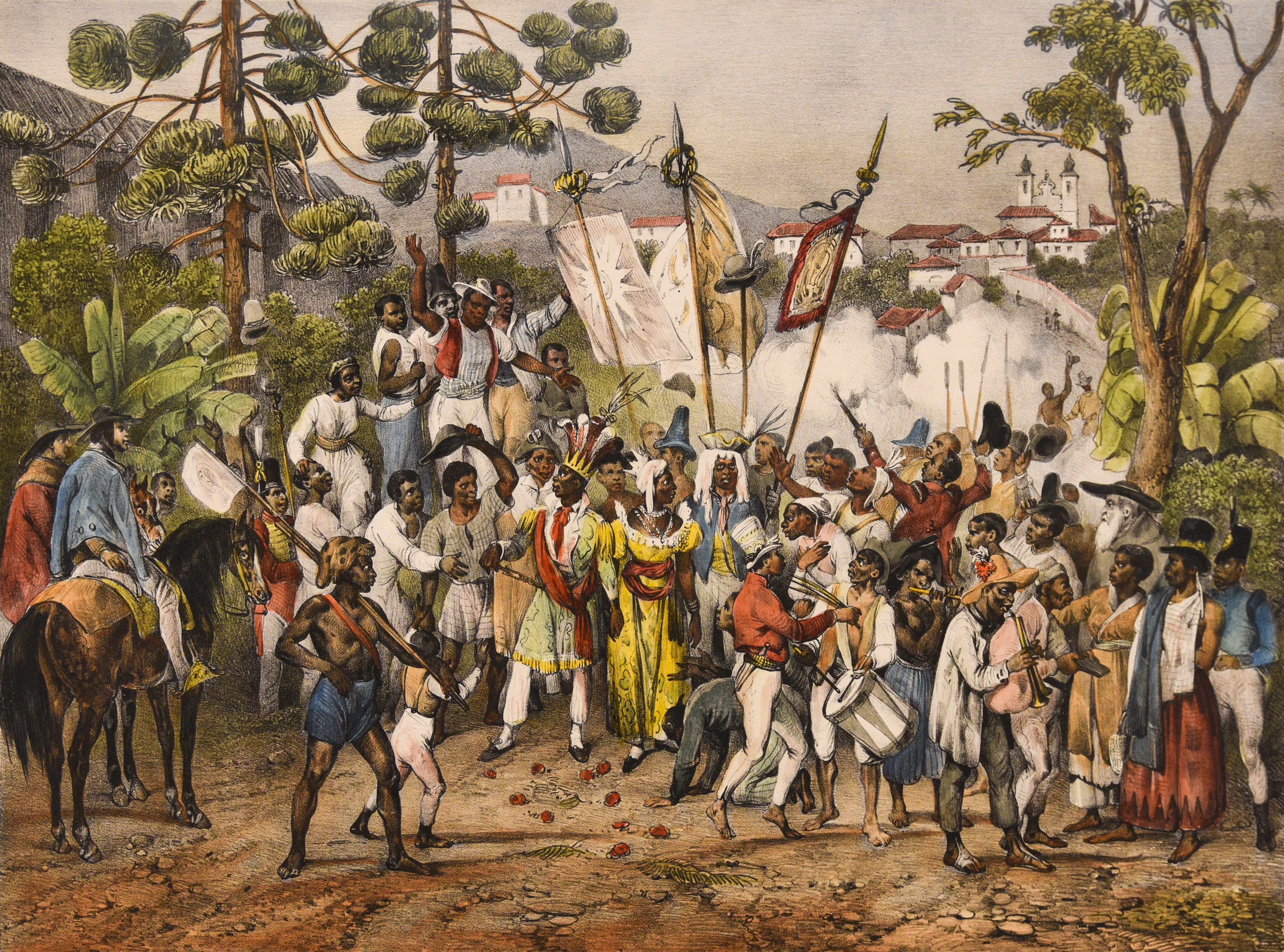
Fête de Ste. Rosalie, Patrone des négres by Johann Moritz Rugendas: Pinkster is far from being the only example where members of the slave community elected and celebrated their ‘king’ with a procession; this illustration from Rugendas shows a slave king procession in 19th-century Brazil
[youtube https://www.youtube.com/watch?v=JBREEYJ3Ibc&w=560&h=315]
King processions by brotherhoods still today exist in rural parts of Latin-America. This example comes from Pernambuco, Brazil.
You do find such examples of pragmatism, but I would be careful of explaining this as a natural Dutch instinct, as has been done in books about Dutch exceptionalism. But, as a general observation, you can state that compared to the Portuguese and Spanish, the Dutch were more focused on profit and reluctant to share their culture, language, religion and identity with Others. In this respect it was not a problem for the Dutch to have a large community around them who did not share their language and church, which was unthinkable for the Portuguese and Spanish. Indonesia is the clearest case of this, where the Dutch used a local language—Malay—as the lingua franca of their colony.
Derek: A common feature of many works of Atlantic History is that the Atlantic world—however we define it—forms a distinctive space in which innumerable hybrid identities are possible, rather than strictly national ones. Syncretism is crucial to this, and your book is a careful excavation of the syncretic process behind Pinkster. Though in our teaching and writing it can be easy to deploy this term rather casually. Has this study led to any general guidance or framework you would propose to other scholars seeking to understand syncretism in the Atlantic beyond the generalizations we tend to use about it?
Jeroen: Saying that something is syncretic is in a way saying nothing. Because, then what is it? You see this reflected in the way how we study black identity in the diaspora. In the old days, the nineteenth century, African elements were simply neglected. In the forties, you see a shift in which scholars become more interested in signs of African cultural “survivals,” which ultimately leads to a boom in the search for “Africanisms”—traces of African identity in the Americas. The important question I raise in this book is: How African are such Africanisms? There has been a clear tendency to equalize Africanisms with indigenous African elements. What the book made me realize is that indigenous African element certainly were there, but I highlight the fact that it would be wrong not to realize that long before the first slaves arrived in North America, a syncretic process had already started on African soil. So, when you look at performance traditions, you see that in certain parts of Africa – such as the Kingdom of Kongo – certain performances had already been influenced by European music, dance, musical instruments, clothing, etc. before coming to the Americas and the Caribbean.
To come back to Pinkster: Dutch elements were certainly in Pinkster performances, but ultimately they were less important than earlier Afro-Iberian ones. Obviously, we are forced to an extent to speculate on matters of African heritage. Mine is not the final word on Pinkster, but a new perspective that helps us rethink the history of this phenomenon. It is also another approach to the study of syncretic processes that is truly Atlantic in the sense that you avoid the mistake of looking at the powers – including African powers – of the Atlantic as pure entities with clear boundaries between them.
My suggestion when using the term syncretism, is not to see it as an answer to your question, but as a stepping stone to begin answering the question of what this syncretism consists of and how it came into being. After all, every cultural manifestation in syncretic in nature, so it would be wrong to limit the notion to the Americas and the Caribbean. I’m not the first one to do this; there are many other studies that raise such questions, but somehow in the field of performance studies there seems to be a reluctance to accept that some of the performance traditions enslaved Africans brought to the Americas were not indigenous in nature but rather characterized by inter-African and Afro-European syncretism. In the field of linguistics, for instance, there are plenty of studies that show us the important influence of Portuguese on the languages that enslaved Africans brought with them to the Americas. So, if language was influenced, why not dance, parades or certain musical instruments? My only explanation for this is that many of those working in the field of performance studies are deeply influenced by the idea of black resistance against oppression that grew out of the Civil Rights movement ideology, and are perhaps therefore reluctant to recognize that already in African, Africans voluntarily adopted certain elements of European culture and religion in their own cultural and religious traditions.
Derek: Importantly, you depict that the Afro-Catholic syncretism behind Pinkster took place at a moment when Africans and Europeans were on more equal terms in Africa, as compared to in the Americas.
Jeroen: Which makes me wonder if it makes sense to use the same term both in the context of colonial oppression and in an era when Africans were still firmly in control of the African continent. We call that syncretism in general. I do feel there is a difference. One thing is integrating elements of a foreign culture into your own when you are in a situation of power; one very different thing is you adopting foreign elements when you are a slave. Nevertheless we use the term syncretism for both.
Derek: You’ve mentioned brotherhoods and other voluntary organizations as a motive force in propelling this performance around the Atlantic and across centuries.
Jeroen: What this book taught me is that when you want to learn about matters of identity and culture, you need to ask how the community organized mutual aid. We as twenty-first-century people have perhaps forgotten this because we have all these services provided. This is a key question: how did a community organize mutual aid? This crucial question leads us to the fields of performance, but also language and religion. I often see in studies of religion a limitation to questions of spiritualism, and much less a focus on questions of material support and solidarity within the religious community. In fact, one of my most surprising conclusions in this book is that, originally, there was little difference between the way slaves in North America organized themselves from the way slaves in Latin-America did. Crucial differences only then start to develop when slaves in North America embrace Protestantism and begin to organize mutual aid as part of a community with (Afro-)Protestant norms and values.
Derek: How has this project influenced your research interests?
Jeroen: This led me to look at black performance traditions elsewhere in America, and naturally I became interested in the case of New Orleans. And to my surprise, I learned that all major contemporary performance traditions related to the black community in New Orleans can be traced back to mutual aid societies. I wrote an article about this for the Louisiana Historical Association (“From Moors to Indians: The Mardi Gras Indians and the Three Transformations of St. James”), which they selected as the best article of the year 2016. In the article I ask how we can link the dances in Congo Square in New Orleans to carnival traditions such as the Mardi Gras Indians, and I show that the missing link is the existence of black mutual aid societies in New Orleans. Societies that, unlike in the case of Pinkster where they disappeared in the context of the “Second Great Awakening”, are still there in New Orleans. I decided to expand it, which is now leading to a new book to be entitled From the Kingdom of Kongo to Congo Square, and to be published in the coming months by the University of Louisiana Press.



1 Pingback